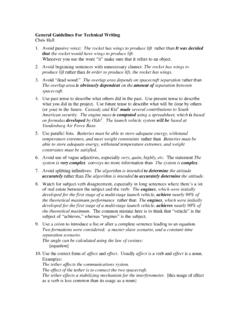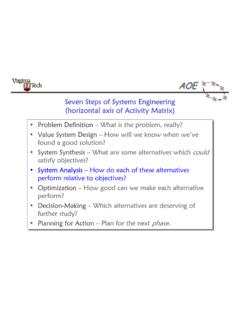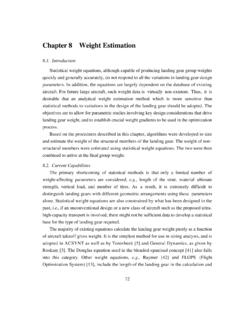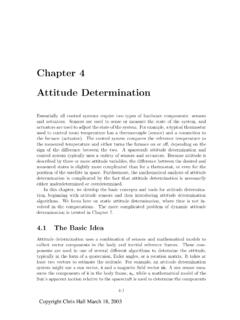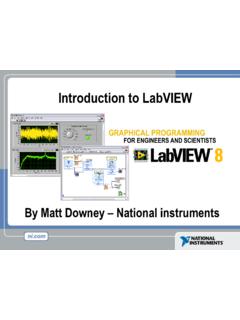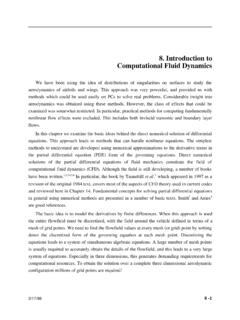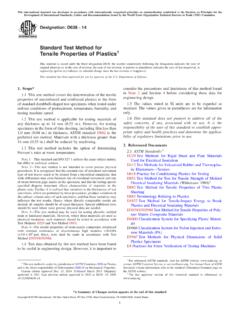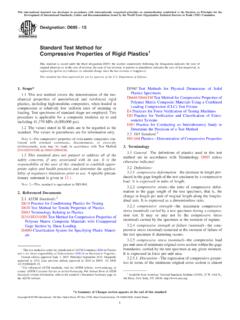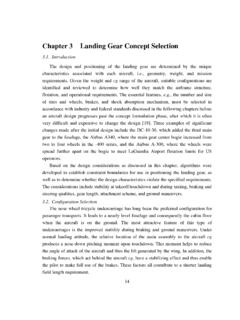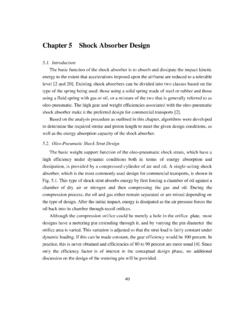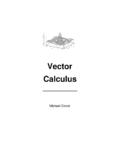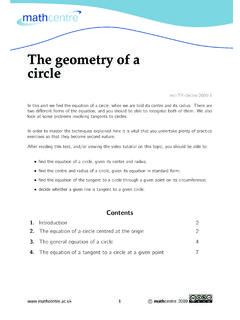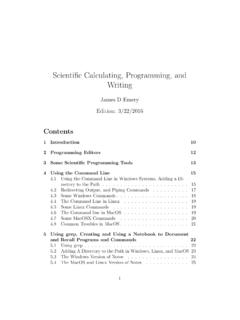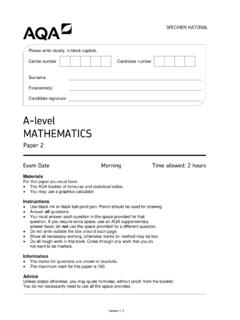Transcription of Appendix A Geometry for Aerodynamicists - Virginia Tech
1 10/23/97A-1 Appendix AGeometry for AerodynamicistsAerodynamicists control the flowfield through Geometry definition, and are always interested inpossible geometric shapes that would be useful in design. This Appendix provides the detaileddefinition of many of the classic shapes frequently specified in aerodynamics. It is notencyclopedic. Section gives some other sources for airfoils. Airfoil Geometry The NACA AirfoilsThe NACA airfoils were designed during the period from 1929 through 1947 under the directionof Eastman Jacobs at the NACA s Langley Field Laboratory.
2 Most of the airfoils were based onsimple geometrical descriptions of the section shape, although the 6 and 6A series weredeveloped using theoretical analysis and don t have simple shape definitions. Although a newgeneration of airfoils has emerged as a result of improved understanding of airfoil performanceand the ability to design new airfoils using computer methods, the NACA airfoils are still usefulin many aerodynamic design applications. A number of references have been included to allowthe reader to study both the older NACA literature and the new airfoil design ideas.
3 Takentogether, this literature provides a means of obtaining a rather complete understanding of theways in which airfoils can be shaped to obtain desired performance NACA airfoils are constructed by combining a thickness envelope with a camber or meanline. The equations which describe this procedure are:xu=x ytx( )sin yu=ycx( )+ytx( )cos (A-1)andxl=x+ytx( )sin yl=ycx( ) ytx( )cos (A-2)where yt(x) is the thickness function, yc(x) is the camber line function, and =tan 1dycdx (A-3)is the camber line slope. It is not unusual to neglect the camber line slope, which simplifies theequations and makes the reverse problem of extracting the thickness envelope and mean line fora given airfoil primary reference volume for all the NACA subsonic airfoil studies remains:Abbott, , and von Doenhoff, , Theory of Wing Sections, Dover, following paragraphs provide a brief history of the development of the NACA B provides references to the development of the NASA advanced airfoils, which weredeveloped from 1966- approx.
4 Applied Computational Aerodynamics10/23/97 Primary Evolution of the NACA airfoils NACA Report Authors Date 1. The 4-digit foils: According to Abbott, R-460 Jacobs, Ward1933 Pinkerton found that the thicknessand Pinkertondistribution of the Clark Y and Gottingen 398airfoils were similar, and Jacobs selecteda function to describe this thickness mean lines were selected to be describedby two parabolic arcs which were tangentat the position of maximum The 4-digit modified foils: The camber R-492 Stack and1934lines were identical to the 4-digit series,von Doenhoffand a more general thickness distributionwas defined, which allowed variations inthe leading edge radius and position ofmaximum thickness to be The 5-digit foils: The thickness distribution R-537 Jacobs,1935was kept identical to the 4-digit series, and R-610 Pinkerton and1937a new camber line was defined which Greenbergallowed for camber to be concentrated nearthe leading edge.
5 A reflexed camber line wasdesigned to produce zero pitching moment,but has generally not been used. These foilswere derived to get good high lift withminimum The 6-series foils: The foils were designed R-824* Abbott,1945to maintain laminar flow over a large von Doenhoffportion of the chord by delaying the adverseand Stiverspressure gradient. The thickness envelopewas obtained using exact airfoil theory,and no simple formulas are available to describethe shapes. The camber lines were designedusing thin airfoil theory and simple formulas areavailable which describe their The 6A-series foils:To improve the trailing edge R-903*Loftin1948structurally, the foils were designed to providesections with simple (nearly straight) surfacegeometry near the trailing edge, while maintainingthe same general properties as the 6-series camber line can be described by a simplealteration of the standard 6-series mean accounts of the NACA airfoil program are contained in.
6 Abbott, , Airfoils, Evolution of Aircraft Wing Design, AIAA Dayton SectionSymposium, March 1980, AIAA Paper 80-3033. * Additional section data is contained in NASA R-84, 1958, by Patterson and A: Geometry A-310/23/97andJones, , Recollections From an Earlier Period in American Aeronautics, AnnualReview of Fluid Mechanics, Vol. 9, pp. 1-11, has published two reports describing computer programs that produce the NACA airfoilordinates:Ladson, , and Brooks, , Jr., Development of a Computer Program to ObtainOrdinates for the NACA 4-Digit, 4-Digit Modified, 5-Digit, and 16-Series Airfoils, NASATM X-3284, November , , and Brooks, , Jr.
7 , Development of a Computer Program to ObtainOrdinates for the NACA 6- and 6A-Series Airfoils, NASA TM X-3069, September program is included in the utility programs described in App. E, as LADSON. It is notextremely accurate for sections less than 6% thick or greater than 15% extensive and excellent survey of the older airfoils is contained in the German book(available in English translation):Riegels, Airfoil Sections, Butterworths, London, 1961. (English language version)NASA supercritical airfoil development is described in the following references:Whitcomb, Review of NASA Supercritical Airfoils, ICAS Paper 74-10, August 1974(ICAS stands for International Council of the Aeronautical Sciences)Harris, , NASA Supercritical Airfoils, NASA TP 2969, March , , The High-Speed Airfoil Program, in The High Speed Frontier, NASA SP-445, NACA 4-Digit AirfoilThe numbering system for these airfoils is defined by.
8 NACA MPXX whereXX is the maximum thickness, t/c, in percent is the maximum value of the mean line in hundredths of chord,P is the chordwise position of the maximum camber in tenths of the that although the numbering system implies integer values, the equations can provide 4digit foils for arbitrary values of M, P, and example: NACA 2412 a 12% thick airfoil, a max value of the camber line of , at x/c = NACA 4-digit thickness distribution is given by:ytc=tc a0x/c a1x/c() a2x/c()2+a3x/c()3 a4x/c()4[](A-4)where:a0 = = = = = Applied Computational Aerodynamics10/23/97 The maximum thickness occurs at x/c = , and the leading edge radius isrLEc = 2(A-5)The included angle of the trailing edge is: TE=2 tan (A-6)It is important to note that the airfoil has a finite thickness at the trailing camber line is given by.
9 Ycc=MP22P x/c() x/c()2[]dycdx=2MP2P x/c()() xc <P(A-7)andycc=M1 P()21 2P+2P x/c() x/c()2[]dycdx=2M1 P()2P x/c()() xc P(A-8)The camber line slope is found from (A-3) using (A-7) and (A-8), and the upper and lowersurface ordinates resulting from the combination of thickness and camber are then computedusing equations (A-1) and (A-2).The NACA 5-Digit AirfoilThis airfoil is an extension of the 4 digit series which provides additional camber lines. Thenumbering system for these airfoils is defined by:NACA LPQXX where XX is the maximum thickness, t/c, in percent is the amount of camber; the design lift coefficient is 3/2 L, in tenthsP is the designator for the position of maximum camber, xf, where xf = P/2,and P is given in tenths of the chordQ = 0; standard 5 digit foil camber= 1.
10 Reflexed camberAppendix A: Geometry A-510/23/97An example: NACA 23012, is a 12% thick airfoil, the design lift coefficient is , the positionof max camber is located at x/c = , and the standard 5 digit foil camber line is thickness distribution is the same as the NACA 4 digit airfoil thickness distributiondescribed above in equation (A-4).The standard five-digit series camber line is given by:ycc=K16x/c()3 3m x/c()2+m23 m()x/c()[]dycdx=K163x/c()2 6m x/c()+m23 m()[] 0 x/c() m(A-9)andycc=K16m31 x/c()[]dycdx= K16m3 m<x/c() 1(A-10)where m is not the position of maximum camber, but is related to the maximum camber positionby:xf=m1 m3 (A-11)and m is found from a simple fixed point iteration for a given xf.
